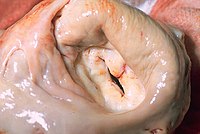
Photo from wikipedia
Abstract This study aimed to evaluate the association between blood neutrophil-to-lymphocyte ratio (NLR) and severity of coronary artery disease (CAD), and investigate the diagnostic ability and optimal cut-off value of… Click to show full abstract
Abstract This study aimed to evaluate the association between blood neutrophil-to-lymphocyte ratio (NLR) and severity of coronary artery disease (CAD), and investigate the diagnostic ability and optimal cut-off value of NLR in predicting severe stenosis in CAD. A systematic search was conducted in public databases to identify all relevant studies. Weighted mean difference (MD) and 95% confidence interval (CI) were pooled for continuous univariate data, and odds ratios (OR) and 95% CI were calculated for dichotomous multivariate data. Seventeen studies were included in this meta-analysis with a total of 7017 CAD cases. For continuous univariate data, the cases with the highest stenosis category had a significantly higher NLR level than those with lowest stenosis category (MD: 1.57, 95% CI: 1.06–2.09; n = 17). After further classification according to the Gensini or SYNTAX score, the cases with severe stenosis demonstrated a higher NLR than those with mild stenosis (MD: 2.33, 95% CI: 1.22–3.43; n = 6) and moderate stenosis (MD: 1.92, 95% CI: 0.80–3.04; n = 6). Compared with mild stenosis, NLR was also higher in those with moderate-to-severe stenosis (MD: 1.34, 95% CI: 0.77–1.92; n = 6) and moderate stenosis (MD: 0.52, 95% CI: 0.36–0.68; n = 6). For dichotomous multivariate data, high NLR levels were recognized as an independent predictor for severe stenosis in CAD (OR: 1.50, 95% CI: 1.32–1.72; n = 11). NLR showed a diagnostic ability in predicting severe stenosis in CAD (area under receiver operating characteristics [ROC] curve [AUC]: 0.66, 95% CI: 0.64–0.68; n = 8), with the cut-off ranging from 1.95 to 3.97. Subgroup analysis and sensitivity analysis showed the results were robust. Begg's test detected no significant publication biases. This study suggested that high blood NLR was associated with the severity of CAD, and it might be useful for predicting severe stenosis in CAD.
Journal Title: Medicine
Year Published: 2018
Link to full text (if available)
Share on Social Media: Sign Up to like & get
recommendations!